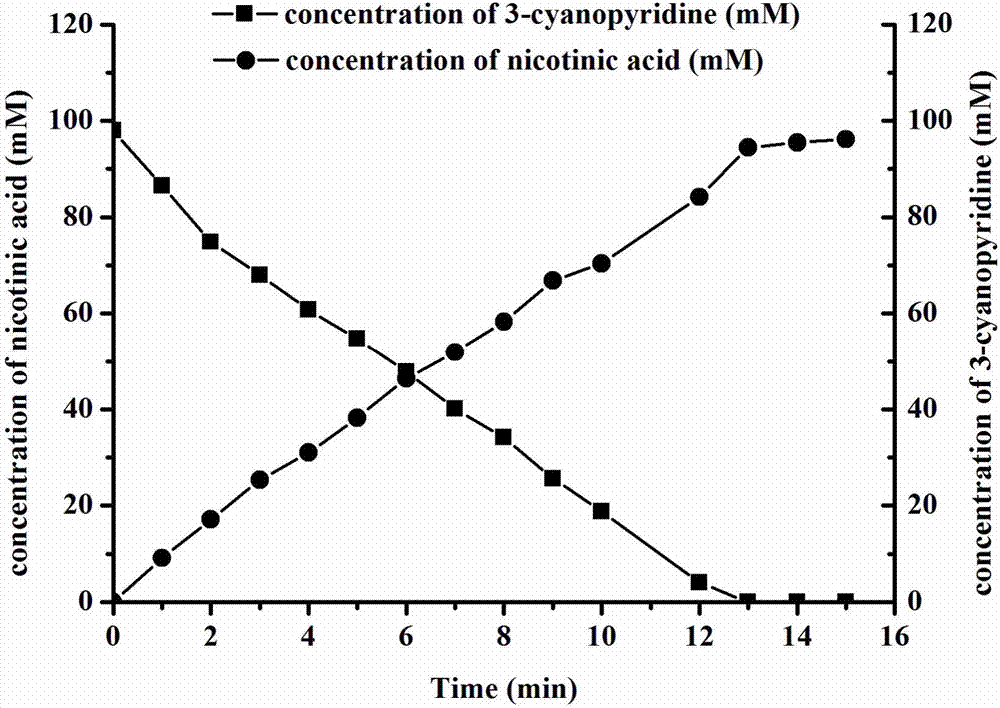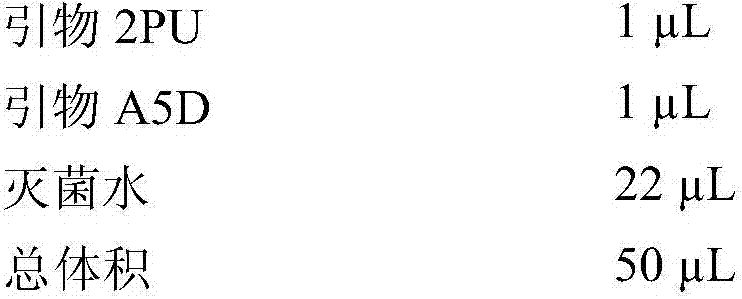Bacillus subtilis for high yield of recombinant nitrilase and application of bacillus subtilis
A technology of Bacillus subtilis and nitrilase, which is applied in the fields of genetic engineering and enzyme engineering, can solve problems such as increasing process steps and production costs, achieves good application prospects, improves process efficiency, and reduces production costs.
- Summary
- Abstract
- Description
- Claims
- Application Information
AI Technical Summary
Problems solved by technology
Method used
Image
Examples
Embodiment 1
[0020] Example 1: Construction of Bacillus subtilis NIT-2 producing recombinant nitrilase
[0021] 1) Amplification of the NIT sequence of the nitrilase gene: Genomic DNA was extracted from Pseudomonas putida CGMCC3830, used as a template, and upstream and downstream primers 2PU and A5D were designed, and Nde I and MluI restriction sites were added at both ends , for PCR amplification, primers:
[0022] 2PU: 5'-GGAATTC CATATG ATGGTTACGTACACGAATAAGTT-3'
[0023] A5D: 5'-CG ACGCGT TCAGCTCTCTTCATGGACCTTAA-3'
[0024] PCR amplification system:
[0025]
[0026]
[0027] PCR reaction program: cycle after pre-denaturation at 95°C for 3 minutes, denaturation at 95°C for 30 s, annealing at 59°C for 30 s, extension at 72°C for 90 s, a total of 30 cycles; final extension at 72°C for 5 min; incubation at 12°C to obtain Nde at both ends Nitrilase gene NIT at I and Mlu I restriction sites.
[0028] 2) Preparation of pMA5 plasmid containing Nde I and Mlu I restriction enzymes:...
Embodiment 2
[0034] Embodiment 2: Preparation of Bacillus subtilis NIT-2 free cells
[0035] Centrifuge the fermentation broth cultured in TB medium for 8-10 hours at 12,000×g for 1 min, discard the supernatant, resuspend the bacteria with pH 7.2, 100 mM sodium phosphate buffer (PBS) and wash 2-3 times , to obtain the cells after removing the culture medium residue, and finally resuspend the cells with the same sodium phosphate buffer to obtain a free cell suspension, measure the concentration of the cells and store them in a refrigerator at 4°C for later use.
Embodiment 3
[0036] Embodiment 3: biotransformation synthetic nicotinic acid
[0037] Mix the prepared free-cell bacterial suspension (100mL, the dry weight of the bacteria is 2.87g / L) with 1.04g 3-cyanopyridine (the initial concentration of 3-cyanopyridine is 100mM), and carry out at 30°C and 220rpm. In the conversion reaction, the remaining substrate in the conversion solution is detected by HPLC, and when the substrate is completely converted, the conversion solution containing niacin is obtained.
[0038] The free cells of Bacillus subtilis NIT-2 can completely convert 100mM substrate within 13min, the conversion rate of 3-cyanopyridine can reach 100%, and the by-product nicotinamide is not detected by HPLC. The average conversion rate of pyridine was 16.72 g / h.
[0039] SEQ ID NO:1
[0040]Composition 262 A; 293 C; 276 G; 282 T;
[0041] Percentage: 23.5% A; 26.3% C; 24.8% G; 25.3% T;
[0042] Molecular Weight (kDa): ssDNA: 343.21 dsDNA: 686.18
[0043] ORIGIN
[0044] 1 TCAGCTC...
PUM
 Login to View More
Login to View More Abstract
Description
Claims
Application Information
 Login to View More
Login to View More - R&D
- Intellectual Property
- Life Sciences
- Materials
- Tech Scout
- Unparalleled Data Quality
- Higher Quality Content
- 60% Fewer Hallucinations
Browse by: Latest US Patents, China's latest patents, Technical Efficacy Thesaurus, Application Domain, Technology Topic, Popular Technical Reports.
© 2025 PatSnap. All rights reserved.Legal|Privacy policy|Modern Slavery Act Transparency Statement|Sitemap|About US| Contact US: help@patsnap.com



